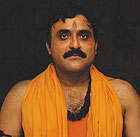|
Civilized and Uncivilized |

|
|
Yogi Ashwini
|
Let’s talk about the Mayan civilization. The name of this civilisation is something else. It is “Maye” (like pranmay kosh, anandmay kosh). And we have had an Asur called Maye danav. He founded it. He was the father-in-law of Raavan. So he started what we call the ‘Mayan civilisation’ around 8,000 years back. When we use the term ‘Asur’ it does not mean somebody who is negative. It is a common misconception that asur means someone bad. It is not necessary that an Asur is a bad person and in the same way it is not necessary that a Sur is a good person. So understand that Sur and Asur are two basic types of communities in this creation and like we know till a few thousand years ago, as told by historians and geologists this world was only one continent called Pangea. And when continental drift occurred, when all the land masses separated from each other, that was the change of a yug. So what we call a civilisation, that is not heritage of only one part of the world, i.e. we cannot say that only India is civilised or only Sur were civilised and not Asur.
We cannot generalise whether only east is civilised or only west is civilised. The debate is only between civilised and uncivilised people and not between sur and asur or black and white or brown or yellow. The debate is not between races, because in every race there are civilised people and uncivilised people as well. There is no race which has only civilised or only uncivilised people, every race has both civilised and uncivilised. So all this culture was earlier one, when the yug changed and continental drift occurred, so human beings got segregated and went to different parts. So a human being has come from one place only, the only differentiation between human beings has been that of civilised and uncivilised.
The second proof for this is that in all the civilizations—Mayans, Egyptian civilisations, Greeks, Vedic civilisation—there is one common thing, they regard cow as a Goddess and Bull as a God as given in their ancient paintings and literatures. So at that time this gyan was there that if you kill a cow then all the nourishment of the creation will finish. Let me tell you a little fact about agriculture. Before tractors came, there never used to be termites in our lands. After the usage of tractors termite infestation began. Why? Because when the bulls were used to plough the land, wherever their hoofs landed at that place no termite can be present. Where cow urine falls, there will be no bacteria there, you won’t need to spray anything.
So the debate is between civilised and uncivilised cultures and not between black or white or yellow or brown. The Gods and Goddesses were also the same of all these civilisations. Now what is the difference between civilised and uncivilised? Like for instance there was somebody by the name Mahishasur, he was an asur and uncivilised. What was his uniqueness? He used to wear a headgear with horns. Similarly even today certain communities are known to have sported a horned headgear. But you cannot call any of these as civilised cultures. These cultures were uncivilised cultures and the signs are right there—wearing head gear with horns. If you take Egyptians or Greeks who were comparatively more civilised, did they wear such a headgear? Or those here, the kings or Vedic Rishis, have you ever heard of them wearing horned head gear? Or Christ and Saint Francis....have you heard of them wearing a horned head gear? It’s not about east or west—it's about civilised or uncivilised traits.
Civilised and uncivilised is not dependent on any region or culture, it is a trait, a nature. It is important for us to understand this. We have so many misconceptions because we have a tendency to typecast people of a particular culture as same. But every culture has both civilised and uncivilised. You cannot call one community civilised or uncivilised, unless they are wearing or behaving like animals! Everybody has been civilised and uncivilised—in Akbar’s reign the civilisation was at its peak where as in Aurangzeb’s times there was no sign of any civilisation at all. So you can’t generalise. Whenever we talk about something it is on thebasis of proper research. We don’t just say anything without any basis.
So we won’t generalise. We will take into consideration the roots of civilisations that we have today. That is why we said that even an Asur is not necessarily uncivilised—somebody who goes about killing people indiscriminately with a sword in hand (the popular misconception that is associated with the term Asur). Rather Asur means Rakshas which has been derived from ‘Raksh’ which means Raksha karne wala (one who protects). So the Rakshas here were not people who used to indulge in violence but they were created to protect, protect the oceans.
|
|
- The Writer Yogi Ashwini Ji is
the head of Dhyan Foundation, Delhi.
For details contact: ashwiniyogi@yahoo.co.in.
|
|
|
|
|
|
|
September 2013
|
|


|
|
|
|